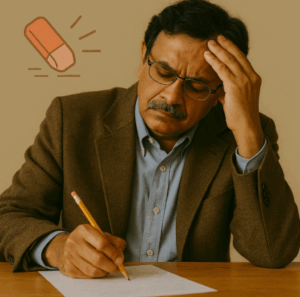🧠 Unwriting the Brain’s Script: V.S. Ramachandran’s Insights on Writer’s Cramp
 What happens when your hand refuses to obey — not out of pain, not because of paralysis, but because the brain has mislearned how to move?
What happens when your hand refuses to obey — not out of pain, not because of paralysis, but because the brain has mislearned how to move?
This is the mystery of writer’s cramp — a task-specific focal dystonia where the act of writing itself becomes distorted. And few thinkers have illuminated such neural puzzles as brilliantly as Dr. Vilayanur S. Ramachandran.
Though writer’s cramp wasn’t his primary research area, Ramachandran’s work on phantom limbs, mirror neurons, and body maps offers deep insight into why writer’s cramp develops and how it might be undone.
✍️ The Central Idea: Writer’s Cramp as a “Learned Paralysis”
Ramachandran’s hallmark explanation of phantom limb paralysis goes like this:
-
After amputation, the brain’s representation of the limb remains.
-
If the limb had been paralyzed before amputation, the brain still believes it cannot move.
-
This is a “learned paralysis” — a maladaptive motor memory.
Now apply that to writer’s cramp:
The hand is intact. The nerves are intact. The muscles are strong.
But the brain has learned a dysfunctional motor program, specific to writing.
Writer’s cramp, in this view, is a “task-specific learned dystonia.”
🧭 Rewriting Body Maps: The Sensory Cortex in Conflict
Ramachandran’s research on cortical remapping (especially in phantom limb pain) revealed that:
-
The brain’s map of the body (somatosensory homunculus) can change over time.
-
If an area (like the hand) is overused or loses proper feedback, adjacent areas invade its representation.
-
This leads to misfiring, miscoordination, and a breakdown in voluntary control.
In writer’s cramp:
-
Overuse of handwriting (without variability) leads to rigid, narrow cortical encoding.
-
GABAergic inhibition is reduced, allowing overlapping motor commands to spill over.
-
This results in the loss of fluidity, tremor, and abnormal postures.
Ramachandran would likely argue that:
“The writer’s hand is caught between what it wants to do, and what the brain insists it must do.”
🪞 The Mirror Box Connection
Ramachandran famously developed the mirror box for phantom limb pain and stroke rehab:
-
By creating the illusion of movement in the paralyzed or missing limb, the brain rebuilds its motor map.
-
This simple trick reopens neural pathways thought to be frozen.
For writer’s cramp, mirror therapy — where the patient views the unaffected hand writing, reflected in a mirror — may:
-
Activate mirror neurons in premotor cortex
-
“Trick” the brain into relearning smooth movement
-
Reconnect vision, proprioception, and intention
This aligns with his broader belief that:
“The brain is not hardwired. It is softwired — and can be rewritten with the right feedback.”
🧬 Mirror Neurons and Movement Simulation
Ramachandran championed mirror neurons — brain cells that fire both when we act and when we observe.
In writer’s cramp:
-
Watching someone else write may activate dormant motor programs.
-
Mental rehearsal (motor imagery) can bypass spasm-inducing pathways.
-
Therapeutic writing exposure can be reconceptualized not just as practice, but as neuro-feedback-based remapping.
🔄 A Ramachandran-Inspired Protocol (Hypothetical)
| Technique | Principle | Mechanism |
|---|---|---|
| Mirror therapy | Visual feedback | Rebuilds motor map |
| Air writing with imagery | Mental rehearsal | Activates motor cortex without dystonic overflow |
| Watching others write | Mirror neuron activation | Facilitates motor relearning |
| Sensory remapping | Texture play, touch mapping | Strengthens proprioception |
| Novel motor tasks | Dance, drawing, non-dominant writing | Encourages flexible encoding |
📘 Final Thoughts
Ramachandran’s core insight is that the brain can fool itself into dysfunction — and fool itself back into function. Writer’s cramp is not a simple muscle problem, but a learned distortion of motor memory, deeply entangled in body image, sensory maps, and the brain’s predictive coding.
Healing it may require not just injections or exercises, but a narrative of relearning, a reintegration of intention, sensation, and action — the very neuroplastic dance Ramachandran devoted his life to decoding.
Written by:
Dr. Srinivas Rajkumar T, MBBS, MD (Psychiatry)
Consultant Psychiatrist
Apollo Clinic, Velachery, Chennai
📧 srinivasaiims@gmail.com | 📱 +91 85951 55808
🌐 www.srinivasaiims.com
If your hand has forgotten how to write, let’s help your brain remember — gently, creatively, and scientifically.